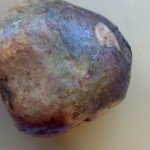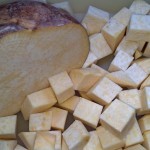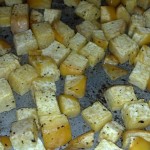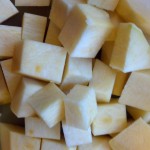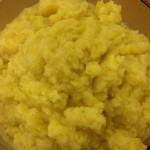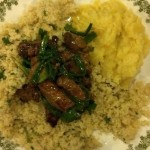This Meatless Monday, we feature two recipes for rutabaga from Vermont Fresh: A Fruit and Vegetable Handbook, as well as growing, storage and preparation tips.
Tracey Kawecki, a volunteer cooking, tasting and testing recipes out of the Vermont Fresh Handbook adapted and tested these two recipes, as well as provided the photos and comments.
Meatless Monday Recipe: Roasted Rutabaga
Preparation Time: 5 minutes
Cook Time: 45minutes
Total Time: 50 minutes
Servings: 4 to 6
- Photo courtesy of Tracey Kawecki
- Photo courtesy of Tracey Kawecki
- Photo courtesy of Tracey Kawecki
Ingredients:
- 1 rutabagas (approx. 2 lbs), peeled, cut into rough 1” chunks
- 2 tablespoon olive oil
- 2 teaspoons sugar
- 1 pinch each salt, pepper, and any herbs desired (I used ½ ts oregano, ½ ts basil)
Instructions:
- Preheat oven to 350°F. Toss rutabaga with oil, sugar, and spices. Spread in single layer on a baking sheet.
- Bake until tender, about 45 minutes. Serve warm, adding more salt if necessary.
Comments:
It tastes good, but I’d probably add a tablespoon of water with the oil/herb mixture. I think it was a little dry, especially since there aren’t any moisture-releasing vegetables in the mix. I like the ease of preparing roasted vegetables. You can throw it in the oven and bake while preparing other dishes. I usually like to have a blend of flavors in my roasted vegetable dish, which could include onions, mushrooms, peppers, asparagus, yams, etc. I’d like to try adding rutabaga to the mix next time.
Meatless Monday Recipe: Mashed Peppered Rutabaga
Preparation Time: 10 minutes
Cook Time: 30 minutes
Total Time: 40 minutes
Servings: 4 to 6
- Photo courtesy of Tracey Kawecki
- Photo courtesy of Tracey Kawecki
- Photo courtesy of Tracey Kawecki
Ingredients:
- 1 large rutabagas (approx. 4 lbs), peeled, cut into rough 1” chunks
- 1⁄2 cup sour cream
- 1⁄2 tsp each salt and pepper
- 1 cup shredded cheese, such as cheddar (optional)
Instructions:
- Fill a large pot halfway with water (roughly 3 quarts). Add ½ ts of salt to water. Let it boil.
- Meanwhile, peel and cube rutabaga.
- Put rutabaga in the boiling water (the water should just cover the rutabaga).
- Boil until fork tender (approx 30 minutes)
- Drain, then return to saucepan over low heat.
- Mash thoroughly; mix in sour cream, salt, and pepper.
- Top with cheese if desired and serve hot.
Comment:
I didn’t use the cheese. I think the rutabaga has a nice delicate flavor. I served it with couscous and stir-fried pork tenderloin. Not a bad combination.
Background
Also called “Swede” or “Swedish turnip,” the rutabaga originated as a cross between a turnip and a cabbage in the 17th century. The name “rutabaga” comes from the old-fashioned Swedish term for the vegetable, which translates quite literally to “root bag.” Though it is most commonly eaten as a root vegetable, the leaves are edible as well. Rutabagas are not an especially popular vegetable, though they are common in certain countries, including the Scandinavian nations and Scotland. In the United States, rutabagas are probably grown more commonly as animal fodder than for human consumption, which belies their many good qualities. Rutabagas tend to be sweeter than turnips and are actually very pretty vegetables, with a baseball-sized globe that has a creamy white base and pinkish top, much like an oversized radish. Another advantage of rutabagas over turnips is that they can be stored for much longer without a noticeable deterioration in quality.
Growing Tips
Rutabagas grow very well in fall weather and, as such, are most commonly sown in the summer for a late-fall harvest. Like the other members of the Brassica family (which includes cabbage and radishes, among many others), rutabagas are best suited to cooler conditions. Uncharacteristically for a Brassica, however, rutabaga seeds won’t have trouble germinating in very warm soil. Sow seeds directly into the ground (about ¾ inch deep) in midsummer, thinning seedlings to about 6 inches apart once they are growing vigorously. Harvest the roots after at least one hard frost for optimal flavor.
Storage
Like many root vegetables, rutabagas store best when the tops are trimmed off but the root is left unwashed. If wrapped loosely in plastic and stored the refrigerator, a rutabaga will last for up to a month—too much longer and they may become rubbery. If packed in sand and stored in a root cellar, however, they have been known to last for as long as a year.
Nutritional Benefits
Rutabagas are low in calories and sodium but high in fiber, calcium, Vitamin C, potassium, and fiber. Potassium, which is crucial to the functioning of your heart, muscles, and kidneys, is also believed to help lower high blood pressure and decrease the risk of stroke.
Preparation
You should always wash a rutabaga before preparing it and will most likely want to peel it as well. Raw rutabagas can be cut into thin sticks and served with dip or diced and tossed into a salad. More commonly, rutabagas are steamed or roasted and served alongside meat. They are also frequently added to stews and casseroles.
To receive more recipes and tips on your favorite fruits and vegetables, download Vermont Fresh: A Fruit and Vegetable Handbook. We also need more volunteer home chefs for this project.
Vermont Foodbank fresh food initiatives would not be possible without your support. Please consider giving to the Vermont Foodbank today!

